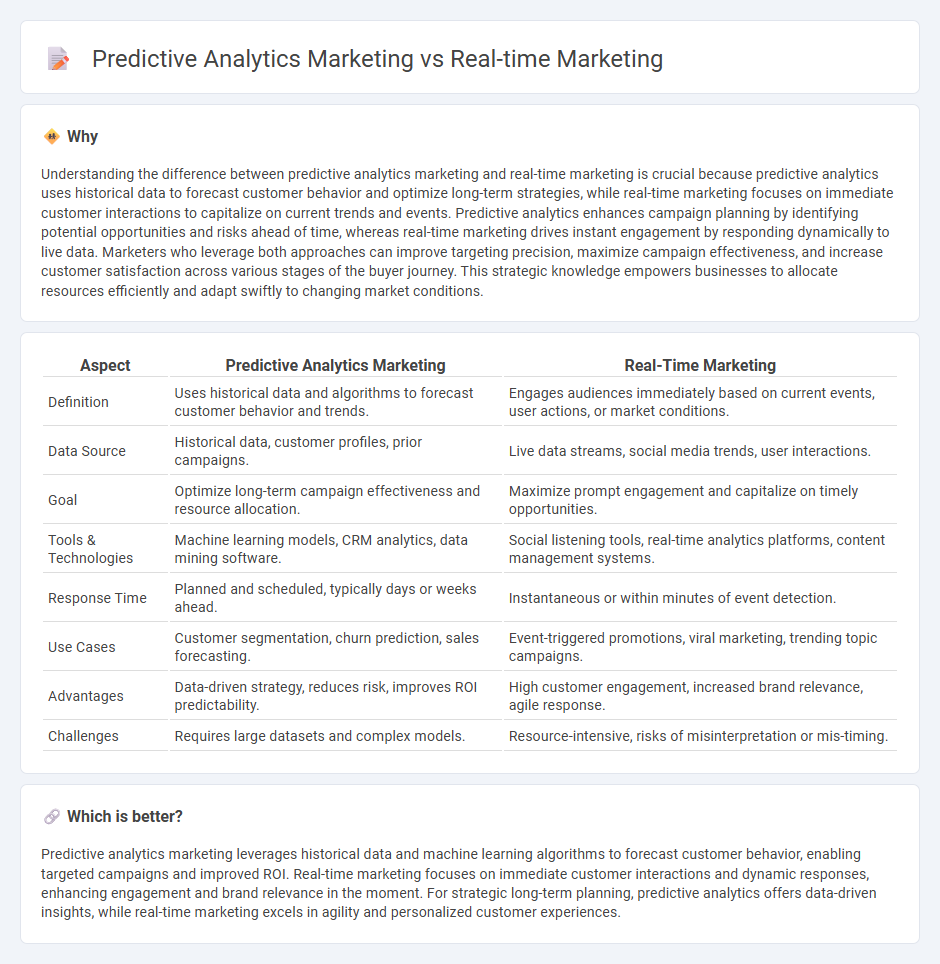
Predictive analytics marketing leverages historical data and machine learning algorithms to forecast future customer behaviors, enabling targeted campaigns that anticipate needs and improve ROI. Real-time marketing focuses on immediate data analysis to deliver personalized content and offers based on current customer actions and market conditions. Discover how integrating both strategies can optimize your marketing effectiveness and customer engagement.
Why it is important
Understanding the difference between predictive analytics marketing and real-time marketing is crucial because predictive analytics uses historical data to forecast customer behavior and optimize long-term strategies, while real-time marketing focuses on immediate customer interactions to capitalize on current trends and events. Predictive analytics enhances campaign planning by identifying potential opportunities and risks ahead of time, whereas real-time marketing drives instant engagement by responding dynamically to live data. Marketers who leverage both approaches can improve targeting precision, maximize campaign effectiveness, and increase customer satisfaction across various stages of the buyer journey. This strategic knowledge empowers businesses to allocate resources efficiently and adapt swiftly to changing market conditions.
Comparison Table
| Aspect | Predictive Analytics Marketing | Real-Time Marketing |
|---|---|---|
| Definition | Uses historical data and algorithms to forecast customer behavior and trends. | Engages audiences immediately based on current events, user actions, or market conditions. |
| Data Source | Historical data, customer profiles, prior campaigns. | Live data streams, social media trends, user interactions. |
| Goal | Optimize long-term campaign effectiveness and resource allocation. | Maximize prompt engagement and capitalize on timely opportunities. |
| Tools & Technologies | Machine learning models, CRM analytics, data mining software. | Social listening tools, real-time analytics platforms, content management systems. |
| Response Time | Planned and scheduled, typically days or weeks ahead. | Instantaneous or within minutes of event detection. |
| Use Cases | Customer segmentation, churn prediction, sales forecasting. | Event-triggered promotions, viral marketing, trending topic campaigns. |
| Advantages | Data-driven strategy, reduces risk, improves ROI predictability. | High customer engagement, increased brand relevance, agile response. |
| Challenges | Requires large datasets and complex models. | Resource-intensive, risks of misinterpretation or mis-timing. |
Which is better?
Predictive analytics marketing leverages historical data and machine learning algorithms to forecast customer behavior, enabling targeted campaigns and improved ROI. Real-time marketing focuses on immediate customer interactions and dynamic responses, enhancing engagement and brand relevance in the moment. For strategic long-term planning, predictive analytics offers data-driven insights, while real-time marketing excels in agility and personalized customer experiences.
Connection
Predictive analytics marketing leverages historical data and machine learning algorithms to forecast consumer behavior, enabling brands to tailor campaigns with precision. Real-time marketing uses these insights to deliver personalized content and offers instantly as customer interactions occur across digital platforms. Together, they enhance customer engagement, increase conversion rates, and optimize marketing ROI by aligning predictive foresight with immediate action.
Key Terms
Immediate Engagement
Real-time marketing leverages instantaneous customer data and social media trends to deliver timely, personalized messages that boost immediate engagement and conversion rates. Predictive analytics marketing uses historical data and machine learning algorithms to forecast consumer behavior and optimize long-term campaign strategies. Explore more to understand how these approaches can transform your marketing outcomes.
Data Forecasting
Real-time marketing leverages instant data to tailor campaigns and engage customers dynamically, while predictive analytics marketing uses historical data to forecast future trends and customer behaviors. Data forecasting in predictive analytics allows businesses to allocate resources efficiently and anticipate market changes with greater accuracy. Explore deeper insights into how combining both strategies can elevate your marketing performance.
Customer Behavior Modeling
Customer behavior modeling in real-time marketing captures immediate interactions, enabling dynamic engagement based on current actions and preferences. Predictive analytics marketing uses historical data and algorithms to forecast future customer behaviors, optimizing strategy for long-term outcomes. Discover how these approaches transform customer insights to enhance marketing effectiveness.
Source and External Links
Real-Time Marketing Strategies (With Benefits) - Real-time marketing connects brands with audiences instantly during trending events, improving engagement, relevance, and urgency through timely, varied content.
Real Time Marketing - Real-time marketing is the practice of instantly engaging customers based on breaking news, social trends, or live events, requiring strategic planning around triggers, audience, method, and desired outcomes to stay fresh and impactful.
Real-time marketing - Real-time marketing delivers personalized, context-aware messages to customers "on-the-fly," leveraging advanced data systems and decisioning tools for optimal timing and relevance.
 dowidth.com
dowidth.com